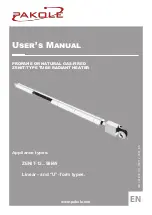
EN
22
When the room temperature reaches the desired value (you can check the
temperature with a thermometer), slowly turn the thermostat knob towards
decreasing the numerical values (relative to the mark) indicated on the knob
until the thermostat switches off the heating mode, which is accompanied by
a characteristic “click” sound. This temperature will continue to be maintained
automatically in the room.
To reduce the temperature in the room, position the thermostat knob relative to the
mark at a lower numerical value, to increase it, at a higher one.
To switch the convector in half power mode (for convectors with a step power
regulator), it is enough to put one of the regulator keys to the “0” position.
6.2 Initializing the anti-freezing function.
Set the thermostat knob to the «
» position and turn on the convector.
6.3 Disconnecting the convector from the mains.
Set the switch key to “0” position, unplug the convector power cord from the outlet.
6.4 Some recommendations when choosing models of convectors and
their operation.
The choice of the rated power of convectors when they are used as the main source
of heating should be made based on the calculation of 100 W per 1 m2 of area (for
rooms with normal thermal insulation and a wall height of not more than 3 m). In
other cases, the choice of convector power should be carried out by a qualified
specialist with a calculation of the actual heat loss of a particular room.
To reduce electricity costs:
- keep track of the achievement of the set temperature in the room on time;
- turn off the convector when ventilating the room;
- if you are not in the room for less than 2 hours - do not change the thermostat
settings, and if you are not in the room for more than 24 hours - set the thermostat
knob to the «
» position;
- if several convectors are installed in the room, synchronize their work by setting the
thermostat knobs in the same position.
7. MAINTENANCE
At least once a month, clean the convector grids from
dust with a brush and a vacuum cleaner. Wipe the
housing with a damp cloth. Do not use abrasive or
aggressive materials that can damage the convector
coating.







































